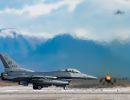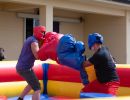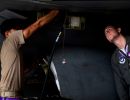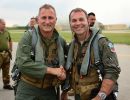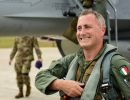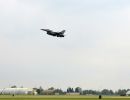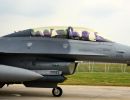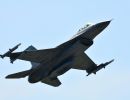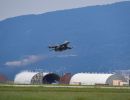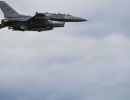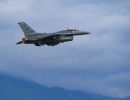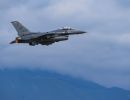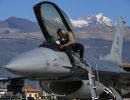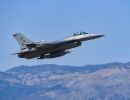Buzzards Go Stateside
Carlson, Ted. Code One: Apr 1999. Vol. 14 No. 2: Pg 2-9.
 Tyndall AFB, Florida, was the first stop for the fifteen Block 40 F-16s sent stateside from Aviano's 31st Wing. At Tyndall, the Buzzards fired live weapons, AIM-120C AMRAAMs and AIM-9M Sidewinders, in the Weapon System Evaluation Program. With all pilots wearing night vision goggles, the unit flew a four-ship night flight to launch two AIM-12OCs. The radar-guided AMRAAMs were fired against BQM-34 Firebee drones. The 510th impressed WSEP personnel by scoring direct hits on both shots. The occasions marked the first time any operational fighter unit fired an AIM-120 at night using NVGs.
Tyndall AFB, Florida, was the first stop for the fifteen Block 40 F-16s sent stateside from Aviano's 31st Wing. At Tyndall, the Buzzards fired live weapons, AIM-120C AMRAAMs and AIM-9M Sidewinders, in the Weapon System Evaluation Program. With all pilots wearing night vision goggles, the unit flew a four-ship night flight to launch two AIM-12OCs. The radar-guided AMRAAMs were fired against BQM-34 Firebee drones. The 510th impressed WSEP personnel by scoring direct hits on both shots. The occasions marked the first time any operational fighter unit fired an AIM-120 at night using NVGs.
 "We flew in the dark a lot in Florida, including flying night formation," explains Lt. Col. Dave Nichols, commander of the 510th. "Tyndall provides perfect airspace and excellent ground controllers. We brought along a couple of guys from our 'Triple Nickel' sister squadron who also participated in NVG four-ship flights. These pilots then went back to Aviano and shared their experiences with their squadron mates. Now, they are working on the night four-ship syllabus."
"We flew in the dark a lot in Florida, including flying night formation," explains Lt. Col. Dave Nichols, commander of the 510th. "Tyndall provides perfect airspace and excellent ground controllers. We brought along a couple of guys from our 'Triple Nickel' sister squadron who also participated in NVG four-ship flights. These pilots then went back to Aviano and shared their experiences with their squadron mates. Now, they are working on the night four-ship syllabus."
The initial WSEP plan for the 510th called for a total of 146 sorties, but the squadron completed five more than that before leaving Tyndall. "Our ability to turn so many sorties is a credit to the jet and to its maintainers," Nichols says. In Italy, the 510th is restricted to twenty-two sorties a day. At Tyndall, the squadron flew up to forty-five sorties a day thanks to the maintenance and weapons personnel ensuring the Buzzards had ready jets for the stepped up pace. In fact, Nichols says pilot crew rest, not aircraft availability, was the limiting factor for generating even more F-16 sorties at Tyndall.
 During their WSEP deployment, the Buzzards also launched five AIM-9M Sidewinders at various targets during the day. "Our hosts at Tyndall were great," continues Nichols. "They even helped us get warmed up for Red Flag, our next stateside stop at Nellis AFB, Nevada." This preparation included dissimilar air combat maneuvering against Tyndall-based F-15s, low-level sorties over the large ranges in Florida, and night four-ship formation flying with NVGs.
During their WSEP deployment, the Buzzards also launched five AIM-9M Sidewinders at various targets during the day. "Our hosts at Tyndall were great," continues Nichols. "They even helped us get warmed up for Red Flag, our next stateside stop at Nellis AFB, Nevada." This preparation included dissimilar air combat maneuvering against Tyndall-based F-15s, low-level sorties over the large ranges in Florida, and night four-ship formation flying with NVGs.
Having assimilated the lessons from WSEP, the 510th departed for Nellis and two weeks of Red Flag exercises. There, the Buzzards experienced phenomenal success exploiting NVG use during nighttime sorties. "One of our goals is to have a full NVG-capable squadron," says Lt. Col. Steve Schrader, operations officer of the 510th who was instrumental in getting the squadron combat operational with NVGs. "As a result, we are deploying in four-ship, six-ship, and eight-ship flights at night during Red Flag missions."
|
|
|
The 510th Fighter Squadron is the first F-16 unit to launch an AMRAAM at night with night vision goggles *The camera shutter was open for several seconds before the bright plume of the missile lit the aircraft. The bright squiggles on the left of this unretouched photo trace the paths of wingtip lights before the missile ignited. The green shades on the right are canopy reflections of the green instrument lighting of the NVG-compatible cockpit. These reflections are intensified by the exposure time that preceded the missile launch. |
 The 510th uses newer 4949-G NVGs, which allow many of the pilots to retain 20/20 vision. These newer NVGs also allow a wider field of view than that provided by earlier ANVIS-6 NVGs. However, NVGs are only part of the equation for night capability. These Block 40 F-16s also feature cockpit and exterior lighting systems that are retrofitted for the goggles and, most importantly, the LANTIRN pods that provide infrared sensors and targeting and navigation information to the pilot.
The 510th uses newer 4949-G NVGs, which allow many of the pilots to retain 20/20 vision. These newer NVGs also allow a wider field of view than that provided by earlier ANVIS-6 NVGs. However, NVGs are only part of the equation for night capability. These Block 40 F-16s also feature cockpit and exterior lighting systems that are retrofitted for the goggles and, most importantly, the LANTIRN pods that provide infrared sensors and targeting and navigation information to the pilot.
"The difference in capability between a jet that doesn't have a LANTIRN system and one that does is amazing," says Schrader. "Without LANTIRN, for example, we would need a flight of eighteen jets to destroy two targets. With LANTIRN, we can destroy two targets per airplane because it improves situational awareness and allows us to keep track of each other. Without LANTIRN, a pilot has no nighttime visual identification capability at all. LANTIRN lets us use the targeting pod to get that visual identification."
 "The LANTIRN system on the F-16 is the ticket to the dance," says Nichols. "LANTIRN, laser-guided bombs, and NVGs set us above the other Block 40 units in the Air Force fleet. Our Block 40s also have the Sure Strike system, an integrated data modem linked to a global positioning system that can give us target coordinates through a data burst from a ground-based transmitter. We use the capability in our Bosnia operations—not only to deliver weapons but also to pinpoint locations. We also use the system in the airborne forward air controller mission as well."
"The LANTIRN system on the F-16 is the ticket to the dance," says Nichols. "LANTIRN, laser-guided bombs, and NVGs set us above the other Block 40 units in the Air Force fleet. Our Block 40s also have the Sure Strike system, an integrated data modem linked to a global positioning system that can give us target coordinates through a data burst from a ground-based transmitter. We use the capability in our Bosnia operations—not only to deliver weapons but also to pinpoint locations. We also use the system in the airborne forward air controller mission as well."
Aviano F-16 units have over two years of experience with Sure Strike. During the Red Flag deployment, pilots from the 510th shared their Sure Strike experience with the 422nd Tactical Evaluation Squadron at Nellis, which is writing the book on airborne FAC missions. 'We helped write the syllabus," offers Schrader. "Now the formal teaching is done at Luke AFB, Arizona, where many former members of the 510th have gone. We teach pilots the system within our squadron as well."
 "Flying the Block 40 F-16 is fantastic," adds Nichols. "It can perform so many missions. One day we can drop GBU-12s, and the next day we can take off with six AMRAAMs. Flying with NVGs, we can drop a GBU from one wing and shoot rockets from the other. We can even fly as nighttime airborne forward air controllers. The F-1 6 performs so many missions so very well that our options are endless. Its flexibility with such a variety of weapons alone challenges pilots to keep current."
"Flying the Block 40 F-16 is fantastic," adds Nichols. "It can perform so many missions. One day we can drop GBU-12s, and the next day we can take off with six AMRAAMs. Flying with NVGs, we can drop a GBU from one wing and shoot rockets from the other. We can even fly as nighttime airborne forward air controllers. The F-1 6 performs so many missions so very well that our options are endless. Its flexibility with such a variety of weapons alone challenges pilots to keep current."
Soon, F-16 capabilities will expand even more with the new Modular Mission Computer and the new GPS-guided weapons (JDAM, JSOW, and wind-corrected munitions). Not sensitive to weather, these weapons will allow pilots to deal with multiple ground targets much easier. Link 16, a new datalink, will add another powerful communication capability to the F-16.
 "We have it all," says Nichols. "We, are used to deploying quickly and operating immediately. The F-16 is mature, easy to sustain, easy to maintain. Its capabilities are tremendous. Many weapon systems out there may be equipped to perform specialized roles better than we can in some applications, but no other squadron can provide the flexibility that an F-16 squadron can, especially F-16 squadrons from the 31st Fighter Wing."
"We have it all," says Nichols. "We, are used to deploying quickly and operating immediately. The F-16 is mature, easy to sustain, easy to maintain. Its capabilities are tremendous. Many weapon systems out there may be equipped to perform specialized roles better than we can in some applications, but no other squadron can provide the flexibility that an F-16 squadron can, especially F-16 squadrons from the 31st Fighter Wing."
"Airpower planners want precision-guided munitions in their theaters," adds Schrader. "We can hit a target precisely from higher altitudes and from safer standoff distances. At Red Flag, we have been establishing tactics for PGMs, especially with NVGs, that we will share with the wing. Ultimately, what we're working on will go into the larger fighter community."
 Taking an entire operational squadron to WSEP and Red Flag and performing NVG missions with true night capability is a giant step for any unit. At Red Flag, the 510th flew night missions in four-ship formations. By allowing pilots to fly in tighter formations at night, the NVGs significantly reduce their exposure to adversaries.
Taking an entire operational squadron to WSEP and Red Flag and performing NVG missions with true night capability is a giant step for any unit. At Red Flag, the 510th flew night missions in four-ship formations. By allowing pilots to fly in tighter formations at night, the NVGs significantly reduce their exposure to adversaries.
"Mission goals are the same day or night," says Nichols. "But night adds more risk from a training standpoint. We have more stringent standards and stricter rules for night missions. We also have to work sound tactics. Last night, for example, we had hits on four hard-to-find targets using GBU-12s. The flight leader, a fairly new four-ship lead, increased his confidence level significantly as a result of the exercise."
 The 510th pilots are getting about three sorties per week Red Flag. Planning for these missions involves largeforce packages of various aircraft, including the Harrier, the F/A-18, F14, F-15E, E-3, MC-130, KC-135, B-1, B-52, and other F-16 models. These aircraft come from USAF units, from the US Navy, and from the US Army as well as from the British Royal Air Force. The opportunity to fly with these varied platforms and be involved in the integration into an air campaign is a learning experience in itself.
The 510th pilots are getting about three sorties per week Red Flag. Planning for these missions involves largeforce packages of various aircraft, including the Harrier, the F/A-18, F14, F-15E, E-3, MC-130, KC-135, B-1, B-52, and other F-16 models. These aircraft come from USAF units, from the US Navy, and from the US Army as well as from the British Royal Air Force. The opportunity to fly with these varied platforms and be involved in the integration into an air campaign is a learning experience in itself.
"Red Flag exercises are a national treasure," reflects Nichols. "Me learning curve we see when we bring so many assets and airplanes together on an instrumented range is amazing, a quantum leap compared to what we can do at home. We get the integration of both air and ground assets within an integrated air defense system. We even have the opportunity to drop live ordnance. Such training makes American airpower the great force it is today."
|
|
|
Pilots of the 510th FS planned their WSEP missions with the host unit, Tyndall's 83rd Fighter Weapons Squadron of the 53rd Weapon Evaluation Group. |

 The Buzzards of the 510th Fighter Squadron from Aviano Air Base in northern Italy packed their travel pods and headed west over the Atlantic early this year to take in a few training opportunities in the United States. At Aviano, the Buzzards and the pilots from their sister squadron, the 555th, train with Italian F-104s and coalition forces located nearby, such as Dutch and Belgian F-16s, Canadian and Spanish F/A-18s, German Tornados, and US Navy fighters. Aviano-based F-16s have also participated in NATO Partnership for Peace exercises and in exchanges with Hungarian MiG-29s, Swedish Viggens, and French Mirage 2000s. Stateside training, however, offers many advantages not readily available in Europe, like firing live weapons and participating in large-scale exercises.
The Buzzards of the 510th Fighter Squadron from Aviano Air Base in northern Italy packed their travel pods and headed west over the Atlantic early this year to take in a few training opportunities in the United States. At Aviano, the Buzzards and the pilots from their sister squadron, the 555th, train with Italian F-104s and coalition forces located nearby, such as Dutch and Belgian F-16s, Canadian and Spanish F/A-18s, German Tornados, and US Navy fighters. Aviano-based F-16s have also participated in NATO Partnership for Peace exercises and in exchanges with Hungarian MiG-29s, Swedish Viggens, and French Mirage 2000s. Stateside training, however, offers many advantages not readily available in Europe, like firing live weapons and participating in large-scale exercises.

























